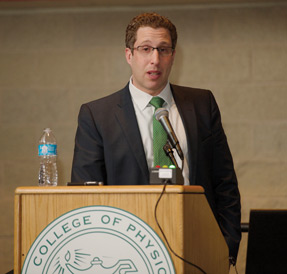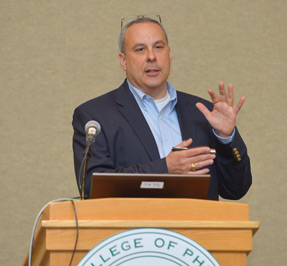A new kind of leadership: the physician and administrator role
It was 6:55 a.m. when I got off the shuttle to the hospital. I was going to be late for my first day on my health administration elective. I thought only surgeons had to get up this early!.
It was 6:55 a.m. when I got off the shuttle to the hospital. I was going to be late for my first day on my health administration elective. I thought only surgeons had to get up this early!
I wondered, not for the last time, why I would want to spend a week waking up this early just to shadow administrators who would barely notice me. But then I remembered that this is what I had wanted to do for a long time. I'd double-majored in biology and business economics, and now I would finally be able to see this collaboration in action.

I was walking—or rather running—through the hallways of St. Mary's Hospital, trying not to slam into physicians, or worse, patients. My heels made a loud noise with each step through the maze of corridors. Was this a hospital or the splenic artery? It was so tortuous! Finally, as I turned the twelfth corner, I saw my mentor getting ready to leave for the meeting without me. Oh no! I thought. What a great first impression. This was going to be a long week.
We sped to the conference room where the Hospital Practice Committee meeting was about to start. The room was occupied by a large mahogany wooden table and fancy leather chairs. Most of the members were already there, each with a coffee and iPad in hand. They looked intense. I couldn't tell if I was in a hospital or the board room on a movie set.
The meeting began. Many of the attendees were physicians; the others were administrators and nurses. They had all had years of experience in the health care field, if not decades. And then there was me, a first-year medical student sitting among them. I felt intimidated and disoriented.
After listening to the minutes from committees I did not even know existed and a detailed financial presentation, I perked up during a discussion on patient safety statistics from the past month. There was a stage 4 decubitus ulcer noted, as well as a lab specimen that had been labeled incorrectly. In addition, the wait time for patients in the ER was skyrocketing, and a patient on one of the wards had had a syncopal event and fallen, breaking her hip.
Most of the people in the room didn't appear surprised to hear each of these unfortunate situations, but they were obviously dismayed. I was bewildered. Didn't mistakes happen at every hospital? Why was everyone so upset?
Then it struck me that because many of these physician administrators practiced medicine and dealt with patients regularly, hearing stories of poor hospital practice personally affected them.
The patient falling in one of the hospital units wasn't just a statistic that they had to control for and report; it was a grandmother of 4 whom they had seen in the clinic last week, who now had her hospitalization complicated by a fractured humerus. The patient waiting in the ER for a long time wasn't simply another number; she was a mother who was now late to go pick up her child from school.
It was almost as if each mishap in the hospital was a personal failure for the people in that meeting. Suddenly, my image of physician administrators morphed from all-business to care and kindness.
There were also several nonclinician administrators on staff—and they were no less concerned. In fact, it was nearly impossible to tell who was who. These were not “number crunchers” or “bean counters.” Instead, they were professionals who were paired with clinical leadership to make the hospital a better place for quality care.
From that meeting, I learned why physicians need to be involved in the administration of a health system. A lack of physician presence might shift the focus from safe patient care to a hospital's bottom line. Hospitals risk dehumanization if major decisions are carried out by those whose focus is not on patient care.
As the week of my health care administration internship continued, I learned, through my discussion with both the physicians and administrators, that those at the Mayo Clinic really do put the needs of the patient first. Using a team-based leadership approach, administrators are able to see what the patients need from the hospital, and the physicians are able to understand what business strategies are available to satisfy those needs. This makes the physician and administrator duo unbeatable.
On the last day of my internship, I walked through the hallways of St. Mary's for what would be the last time in a while, and I noticed 2 professionally dressed individuals sitting at a table in the cafeteria, deep in discussion. I slyly read their nametags: One was a cardiologist, the other a business administrator. I couldn't help but smile.




